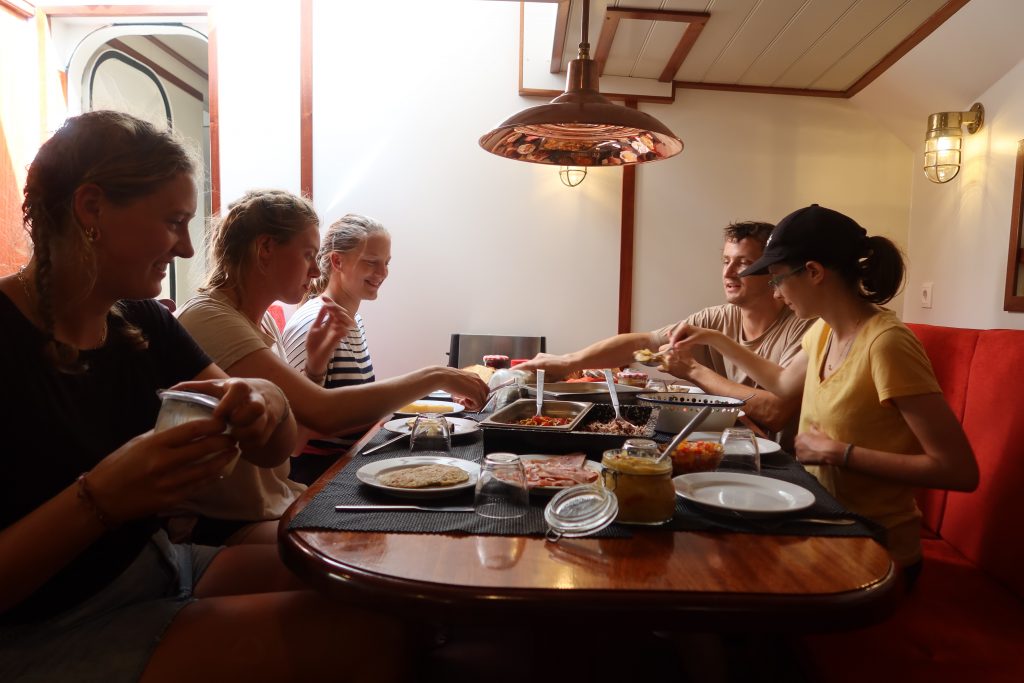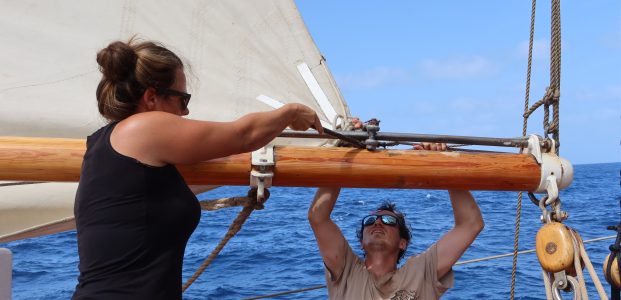Reading: The Whistleblower (Robert Peston) – finished
Weather: NW-NE 2-5, all over the place during showers, but otherwise light
Thought for the day: Squalls in the doldrums are like a microcosm of a weather system in a small, but deadly package …..
Evening meal: A South African curried pudding with rice and salad
Course: 170-260oC during squalls, but otherwise around 190oC
Distance covered: At 1200 we had done 1,409 miles
Flying fish headcount: Tailing off, but one stinking one going off in the new mizzen when we changed it …..
Today saw the first evidence of doldrum-style activity. This was not, as I had always expected, a flat calm and bright sunshine, but a squall. During the morning watch the sky was gradually clouding over and getting greyer and one element then started to blacken up with rain clearly coming down from it. On the radar Erik established that it was just a few miles away, so called Jet a couple of hours early from her watch. She swung into action and everything vulnerable was moved below and she briefed us on the procedure for getting the topsail down in a hurry. I was on the helm and as the first clouds approached she kept rattling off course changes. Before I knew it, I had gone from steering 170oC to 260oC as the wind shifted around the periphery of the squall and then gradually a little way back again as it drew alongside us. The winds got up, though on this occasion not enough to lower the topsail and the rain came. It wasn’t that bad as the cloud skirted around us quite a bit, but it was enough to wash the decks and tempting to wash ourselves as well! It was refreshing though. In the end this squall wasn’t too bad, but there are standing instructions to call the skipper for all squalls and in the event of seeing waterspouts – not apparently uncommon where the squall retains intense heat within it – we take all the sails down instantly.
As things settled and dried out a little over the next hour Jet decided to change the mizzen. A sudden increase in wind meant that the topsail did suddenly come down, but the wind then settled a little more and gradually dropped. While the intention had always been to change the sails after the doldrums, the gaff on the mizzen had been causing problems, resulting in the set of the sail being more Sainsbury’s shopping bag than streamlined aerofoil. At the end of the gaff is a white metal band where the sail is attached and this is held partly by being clamped around the gaff, but also by a wooden block screwed up against the front edge. We knew the block had come off as it landed on deck during one watch, but then the clamp was clearly not holding either. So, down it came and over the next agonising half hour we watched our skipper perched on the boom directly over the water, calling surgeon-like for the next tool. These included adjustable spanners, drills (predictably the battery ran out in the middle!), screwdrivers, hammers followed more prosaically by various bits of string. Finally done, so the next priority was lunch ….. Then back to putting the new sail (minus dead flying fish!) up. Once three corners were attached, we split up with a group on the throat, a group on the peak and someone holding the topsail sheet to control the gaff while someone else attached the parrel balls around the mast. Slow, stately progress saw a mizzen hoisted that we no longer needed to be embarrassed to look at.
It is still uncertain whether we will have the more traditional doldrums calms along with the squalls. The weather forecasts make it look like we will hold wind all the way through the ITCZ, but forecasts can’t possibly tell us what is going on at this micro-weather level and squalls will clearly be a part of our lives for a couple of days yet. Given that we had to run the engine for eight hours this evening, the forecasts are clearly not that accurate, but the wind did come back and we are still sailing a lot of the time, albeit slowly and intermittently. If all goes to plan though, the rest of the sails will be changed on Wednesday, but watch this space …..


